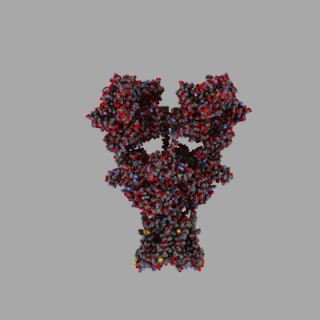Key point: ionotropic receptors are gated by a neurotransmitter, not by voltage. Although some NMDARs are subject to a Mg2+ block, they are voltage dependent but not voltage-gated per se ... the channel itself does not open/close due to depolarisation, none of the NMDAR subunits include voltage sensor, instead the Mg2+ ion falls out into extracellular space. In contrast, a voltage-gated channel changes its conformation (opens/closes) due to a change in voltage (Vm).
Note: glial NMDARs have a weak Mg2+ block at physiological concentrations; their channels can be open at resting membrane potential (Karadottir et al., 2005; Lalo et al., 2006).
Receptor family NC-IUPHAR subunit nomenclature:
- AMPA: GluA1 to GluA4
- Kainate: GluK1 to GluK5
- NMDA: GluN1, GluN2A, GluN2B, GluN2C, GluN2D, GluN3A, GluN3B
The NMDA receptor forms a heterotetramer between two GluN1 and two GluN2 subunits, two obligatory GluN1 subunits and two regionally localised GluN2 or GluN3 subunits (in most cases). However, NMDARs may have 4 or 5 subunits. There are eight variants of the GluN1 subunit and four variants of GluN2 subunit.
GluN2 subunits are expressed differentially across various cell types and control the electrophysiological properties of the NMDA receptor. One particular subunit, GluN2B, is mainly present in immature neurons and in extrasynaptic locations; it contains the binding-site for the selective inhibitor ifenprodil.
However, AMPARs and NMDARs can be built from various combinations of subunits.
The subunit composition of iGluRs and their density at synapses are major determinants of fast synaptic transmission and synaptic plasticity. This is because the subunit stoichiometry determines channel function, trafficking to synapses, and synapse-specific receptor expression. According to recent research RNA editing of AMPA-type iGluRs plays a central role for in these processes, which is currently under investigation.
Karadottir R, Cavelier P, Bergersen LH, Attwell D (2005). NMDA receptors are expressed in oligodendrocytes and activated in ischaemia. Nature 438: 1162–1166.
Lalo U, Pankratov Y, Kirchhoff F, North RA, Verkhratsky A (2006). NMDA receptors mediate neuron-to-glia signaling in mouse cortical astrocytes. J Neurosci 26: 2673–2683.







